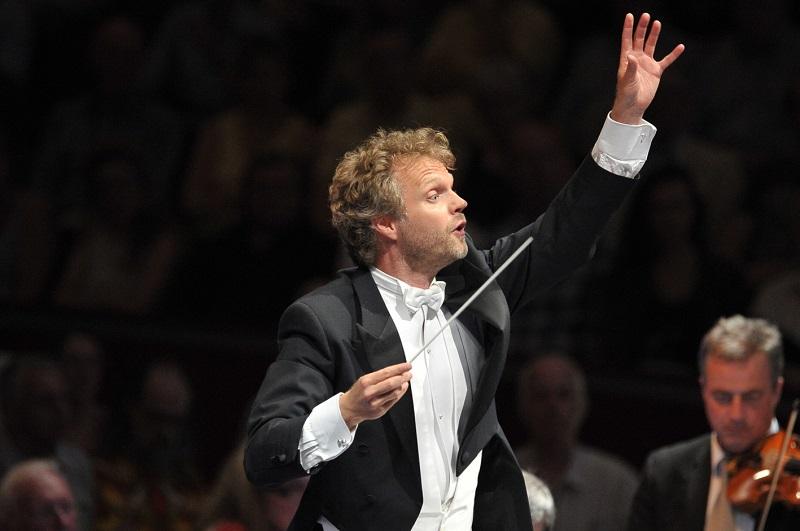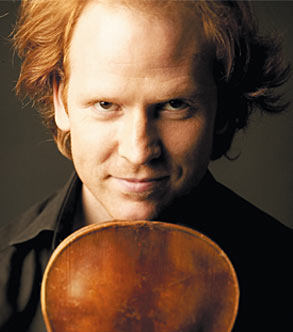Prom 21: Hope, BBC National Orchestra of Wales, Søndergård | reviews, news & interviews
Prom 21: Hope, BBC National Orchestra of Wales, Søndergård
Prom 21: Hope, BBC National Orchestra of Wales, Søndergård
Colin Matthews makes way for two Russian giants

The “Turning Point” in Colin Matthews’ so-named orchestral piece is a change of attitude, a sudden seriousness of purpose, a great effort of will to stop moving and take stock of where it - whatever it is - is going. That Matthews did actually stop mid-composition because, precisely as the piece tells us, he wasn’t sure he was enjoying the ride anymore is one of those extra-musical bits of information that perhaps holds the key to understanding the motivation behind it.
Turning Point was written to a commission from the Royal Concertgebouw Orchestra of Amsterdam and that orchestra’s great tradition in Mahler and Matthews’ own involvement with Deryck Cooke’s performing version of Mahler’s last symphony, the 10th, resonates with the tragic dimension the work eventually assumes or at least alludes to in richly sustained strings. Essentially the whole piece is a whirring, motoric, capricious scherzo that secretly wants to be a slow movement. But the engine of it, centred in the woodwind, is not about to run out of steam. It even morphs into a kind of thundering locomotive (echoes of Honegger’s Pacific 231) at one point. Unstoppable, you think, until it does. The BBC National Orchestra of Wales under the high-octane Danish conductor Thomas Søndergård pointed up the technical accomplishment of Turning Point to great effect. The way they played it - it was definitely about something.
 But then the Russians were coming and Daniel Hope was first up with an interesting take on Prokofiev’s Second Violin Concerto. I say interesting because most players of it are apt to focus on the luxuriance, the shot-silk aspects of the piece. Hope played more on the improvisational, the ephemeral, nature of it, heightening the volatility of the first movement’s switches between action and repose and introducing the beautiful and songful theme of the second movement so quietly as to suggest a shyness to express itself at all. The ensuing flights of fancy were ecstatic but hardly showy.
But then the Russians were coming and Daniel Hope was first up with an interesting take on Prokofiev’s Second Violin Concerto. I say interesting because most players of it are apt to focus on the luxuriance, the shot-silk aspects of the piece. Hope played more on the improvisational, the ephemeral, nature of it, heightening the volatility of the first movement’s switches between action and repose and introducing the beautiful and songful theme of the second movement so quietly as to suggest a shyness to express itself at all. The ensuing flights of fancy were ecstatic but hardly showy.
Søndergård, too, played up the grotesque and fantastical elements in the piece raising awareness of bizarre ideas like the unison between the soloist and string basses at one point and, of course, that quirky duet with the bass drum, an idea which might just have been planted in Prokofiev’s head by Stravinsky a couple of years earlier in his Violin Concerto.
And so to “The Year 1905” and the masterpiece that is Shostakovich’s 11th Symphony. The fabric of it is woven from revolutionary songs that Shostakovich will have remembered from his youth and carried with him until such time - half a century later - they evolved and were transfigured by this magnificent paean to the spirit of revolution and the great sacrifice for change.
The wonder of this piece is that there is nothing and everything on the page. Open fifths in strings, the sound of silence, bugles calling across a frozen Palace Square, harmonies shifting queasily, imperceptively. Something’s coming - and in its wake nothing will ever be quite the same again. That, in essence, is it and when the cor anglais - beautifully played here by Sarah-Jayne Porsmoguer - offers a final lament on the most pervasive revolutionary song of all “Bare your heads” - rising ever higher in the instrument until its pain is most acutely felt - the immediacy of it is overwhelming.
The marvel of this performance - stillness and atmospherics apart - was undoubtedly the fierceness and trenchancy of its rhythmic impulse with Søndergård urging and getting fantastic edge and depth from the BBC NOW strings. The infamous massacre itself had the entire percussion battery quite literally (well, aurally speaking) mowing us down (is there a more dramatic use of percussion in all of music?) and when the bass clarinet signalled dissent in the final pages how thrilling it was to have actual upturned bells (the only option) clanging out the alarum. The final resonance was, of course, cut short by the cheering - not quite what Shostakovich might have hoped for but testament to this visceral music’s ability to go straight for the solar plexus.
rating
Explore topics
Share this article
The future of Arts Journalism
You can stop theartsdesk.com closing!
We urgently need financing to survive. Our fundraising drive has thus far raised £49,000 but we need to reach £100,000 or we will be forced to close. Please contribute here: https://gofund.me/c3f6033d
And if you can forward this information to anyone who might assist, we’d be grateful.

Subscribe to theartsdesk.com
Thank you for continuing to read our work on theartsdesk.com. For unlimited access to every article in its entirety, including our archive of more than 15,000 pieces, we're asking for £5 per month or £40 per year. We feel it's a very good deal, and hope you do too.
To take a subscription now simply click here.
And if you're looking for that extra gift for a friend or family member, why not treat them to a theartsdesk.com gift subscription?
more Classical music
 Scottish Chamber Orchestra, Ibragimova, Queen’s Hall, Edinburgh review - rarities, novelties and drumrolls
A pity the SCO didn't pick a better showcase for a shining guest artist
Scottish Chamber Orchestra, Ibragimova, Queen’s Hall, Edinburgh review - rarities, novelties and drumrolls
A pity the SCO didn't pick a better showcase for a shining guest artist
 Kilsby, Parkes, Sinfonia of London, Wilson, Barbican review - string things zing and sing in expert hands
British masterpieces for strings plus other-worldly tenor and horn - and a muscular rarity
Kilsby, Parkes, Sinfonia of London, Wilson, Barbican review - string things zing and sing in expert hands
British masterpieces for strings plus other-worldly tenor and horn - and a muscular rarity
 From Historical to Hip-Hop, Classically Black Music Festival, Kings Place review - a cluster of impressive stars for the future
From quasi-Mozartian elegance to the gritty humour of a kitchen inspection
From Historical to Hip-Hop, Classically Black Music Festival, Kings Place review - a cluster of impressive stars for the future
From quasi-Mozartian elegance to the gritty humour of a kitchen inspection
 Shibe, LSO, Adès, Barbican review - gaudy and glorious new music alongside serene Sibelius
Adès’s passion makes persuasive case for the music he loves, both new and old
Shibe, LSO, Adès, Barbican review - gaudy and glorious new music alongside serene Sibelius
Adès’s passion makes persuasive case for the music he loves, both new and old
 Anja Mittermüller, Richard Fu, Wigmore Hall review - a glorious hall debut
The Austrian mezzo shines - at the age of 22
Anja Mittermüller, Richard Fu, Wigmore Hall review - a glorious hall debut
The Austrian mezzo shines - at the age of 22
 First Person: clarinettist Oliver Pashley on the new horizons of The Hermes Experiment's latest album
Compositions by members of this unusual quartet feature for the first time
First Person: clarinettist Oliver Pashley on the new horizons of The Hermes Experiment's latest album
Compositions by members of this unusual quartet feature for the first time
 Gesualdo Passione, Les Arts Florissants, Amala Dior Company, Barbican review - inspired collaboration excavates the music's humanity
At times it was like watching an anarchic religious procession
Gesualdo Passione, Les Arts Florissants, Amala Dior Company, Barbican review - inspired collaboration excavates the music's humanity
At times it was like watching an anarchic religious procession
 Classical CDs: Camels, concrete and cabaret
An influential American composer's 90th birthday box, plus British piano concertos and a father-and-son duo
Classical CDs: Camels, concrete and cabaret
An influential American composer's 90th birthday box, plus British piano concertos and a father-and-son duo
 Cockerham, Manchester Camerata, Sheen, Martin Harris Centre, Manchester review - re-enacting the dawn of modernism
Two UK premieres added to three miniatures from a seminal event of January 1914
Cockerham, Manchester Camerata, Sheen, Martin Harris Centre, Manchester review - re-enacting the dawn of modernism
Two UK premieres added to three miniatures from a seminal event of January 1914
 Kempf, Brno Philharmonic, Davies, Bridgewater Hall, Manchester review - European tradition meets American jazz
Bouncing Czechs enjoy their Gershwin and Brubeck alongside Janáček and Dvořák
Kempf, Brno Philharmonic, Davies, Bridgewater Hall, Manchester review - European tradition meets American jazz
Bouncing Czechs enjoy their Gershwin and Brubeck alongside Janáček and Dvořák
 Solomon, OAE, Butt, QEH review - daft Biblical whitewashing with great choruses
Even a top soprano and mezzo can’t make this Handel paean wholly convincing
Solomon, OAE, Butt, QEH review - daft Biblical whitewashing with great choruses
Even a top soprano and mezzo can’t make this Handel paean wholly convincing
 Two-Piano Gala, Kings Place review - shining constellations
London Piano Festival curators and illustrious friends entertain and enlighten
Two-Piano Gala, Kings Place review - shining constellations
London Piano Festival curators and illustrious friends entertain and enlighten

Add comment